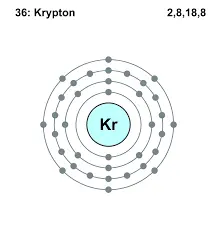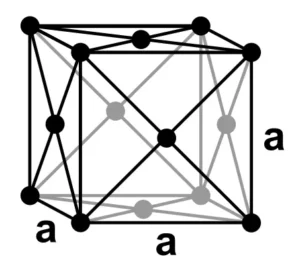Krypton is a unimolecular noble gas which is a chemically inert substance. Let us discuss some important facts around the structure of krypton in detail.
Solid krypton has a face centered crystallographic structure. It is dissolved in water and also radioactive in nature. It is very much less reactive due to its full filled 4s and 4p orbitals. Kr is a brittle and also nonelectrolyte which cannot conduct electricity or heat.
Let us have a clear and detailed idea on the structure and some important properties of krypton.
How to draw krypton structure?
Krypton is a unimolecular gaseous compound. Let us explore about the structure of krypton.
Krypton structure contains 36 number of protons, with 48 neutrons. Both these protons and neutrons form the positively charged nucleus, the center of any atom. To become electrically neutral, 36 electrons are revolving around the nucleus in different orbits.
Electrons are filled in different orbitals from lower energy to higher energy obeying Pauli’s exclusion principle, Hund’s multiplicity rule and Aufbau principle. These rules state that s, p, d and f orbital can accommodate 2, 6, 10 and 14 electrons respectively. Therefore, the electron configuration of Kr becomes 1s2 2s2 2p6 3s2 3p6 4s2 3d10 4p6.

Image Credit: Wikimedia Commons.
Krypton Structure Shape
Most of the noble gas obeys the almost the same structural pattern and krypton is not an exception. Let us talk about it.
Krypton has white and crystalline shape. The crystal of Kr is face centered cubic type which is a common structural property of most of the noble gas (except helium). Krypton is presented as a gaseous molecule under room temperature. It is produced from the fission of uranium.
Krypton is generally a unreactive gas but it can react with highly reactive gaseous fluorine and form krypton fluoride (KrF2) which is linear having bond angle 1800.

Image Credit: Wikimedia Commons.
Krypton Structure Formal Charge
Formal charge can be calculated only in covalently bonded molecule to determine the most stable structure. Let us calculate by using the following formula.
The formal charge of krypton is= {Total number of valance electrons – number of electrons remain as nonbonded – (number of electrons involved in bond formation/2)}. Being a unimolecular compound the number of bonding as well as nonbonding electrons cannot be calculated for an atom.
As the calculation of formal charge is not possible for krypton, it can appear only in one form. If Kr can form bond with any other atom (KrF2) then, formal charge can be calculated and most stable structure can also be determined.
Krypton Structure Resonance
Resonance is the delocalization of electron cloud to stabilize the molecule. Let us explain the resonance structure of krypton.
Resonance structure of krypton is not possible as it is a unimolecular noble gas. The resonance structure can only be drawn for the covalently bonded molecule, for the delocalization of electron cloud. There is no chance of sharing of electron cloud as Kr is not bonded with any other atoms.
Neither Kr has no scope to share its valence shell or nonbonding electrons with any other atom nor it can accept electron pairs from any atom as it is present as single molecule.
Krypton Structure Angle
Angle or bond angle is the angle forming between central atom and two of its substituents. Let us explore the bond angle in krypton.
Krypton structure does not have any angle because it does not form any bond with any other atoms. There is no existence of any atom in Kr because it is a gaseous atom. If Kr participates in bond formation with any atom, then bond angle can be determined.
Krypton Structure Octet Rule
Octet rule is having the same number of valence shell electrons as the nearest noble gas of that atom. Let us discuss the octet rule of Kr in the following stanza.
Krypton obeys octet rule in a different way-
- Krypton is itself a noble gas and has complete shell electron configuration of 4s2 4p6.
- Octet rule is applicable for any covalent molecule to check whether octet rule is satisfied or not for all the atoms present in the molecule because satisfying octet rule give an extra stability to the molecule.
- After satisfying the octet rule, molecule is stabilized. The atom can achieve the complete shell electron configuration and has a little tendency to participate in any reaction.
- Therefore Kr is considered as inert or noble gas as it achieves 4s2 4p6 electron configuration.
Krypton Structure Lone Pairs
Lone pairs or nonbonding electrons have no participation in bond formation with other atoms. Let us explain the lone pairs of krypton.
In Krypton, all the valence shell electrons behave as lone pairs or nonbonding electrons. Formula of calculation of nonbonded electron is = {Total number of valance electron – number of bonded electrons.} As krypton has no bonding electrons, therefore, bonded electrons are zero for Kr because of absence of any bond.
The above explanation is applicable for all of the noble gas atom as well as any single atom as they are not attached through any bonds with other atoms. Therefore, the number of bonding electrons is zero.
Krypton Valence Electrons
The most reactive loosely bound outer most shell electrons are defined as valence electrons. Let us talk about the valence electrons of krypton.
Krypton has total eight valence electrons. These valence electrons belong to the 4s and 4p electrons and n=4 is the valence shell of krypton. Kr has a completely filled 4s and 4p orbitals. Therefore, it is very much less reactive.
Those atoms show high reactivity who has a shortage of one or more than one electron. They can accept or donate electrons to achieve the stability of full filled electron shell which is observed in noble gas of noble gas.
Krypton Hybridization
Hybridization occurs between two atomic orbitals to achieve greater stability. Let us discuss in detail in the following paragraph.
The hybridization of krypton is not possible because it is a single element and for hybridization minimum two atomic orbitals are required. Therefore, hybridization term is not applicable for single element.
Hybridization can only be appropriate for any molecule not any single atom. Kr is not a molecule is a single atom. Thus it has no hybridization.
Krypton Solubility
Solubility, a temperature dependent term, of any substance is the ability to be dissolved in any solvent. Let us explain about the solubility of krypton.
Krypton is dissolved in water as it is presented as an elemental gas. The solubility of Kr in water depends upon the partial pressure of the gas present above the surface of the solvent. Kr is dissolved in water due to the dipole-induced dipole interaction between water and krypton.
This dipole-induced dipole interaction increases with the increasing of molar mass of the noble gas. Thus, solubility also increases going down the group of the periodic table and the solubility of water between the noble gas follows this order Ar< Kr< Xe.
Krypton Uses
Krypton is very much essential noble gas. The uses of it are written below-
- Kr is used as a filling gas in fluorescent lights for energy saving purpose.
- It has a significant use in high-speed photography in some flash lamps.
- Due to the high reactivity with respect to the other noble gases, Kr can react with fluorine to form krypton difluoride.
Is krypton a strong electrolyte?
Electrolytes are defined as those who can be ionized in aqueous solution and can conduct electricity. Let us discuss in detail about it.
Krypton is not a strong electrolyte because it is a nonmetal gaseous substance. Therefore, it is not a good conductor of heat or electricity and it is considered as insulator.
Why krypton is not a strong electrolyte?
To know more about the electrolyte let us follow the below stanza.
Kr is not a strong electrolyte rather it is considered as insulator. Gases are not electrolyte because of their extremely low density and the comparatively larger distance between the molecules with respect to solid and liquids.
How Krypton is not a strong electrolyte?
Due to having some special properties Kr is not a strong electrolyte. Let us explore this.
Krypton is not a strong electrolyte because gaseous substance cannot be ionized when they are dissolved in water due to having larger distance between the atoms or molecules.
Is krypton acidic or basic?
An acid can accept electron pairs in its vacant orbital whether a base donates electron pairs from its filled orbital to any vacant orbital. Let us explain this in detail.
Krypton is neither acid nor base, it is a neutral substance. It has filled 4s and 4p electrons and vacant 4d and 4f orbitals. Therefore, it can donate as well as accept electron pairs. Due to having octet filled up orbitals, Kr does not intent to donate and accept electrons and behaves as inert substance.
Why and how krypton is neither acidic nor basic?
Neither Krypton has no property of base not any acid. Let us talk about this in the next paragraph.
Krypton is neither acidic nor basic because it is more over a neutral or amphoteric substance because it has full filled 4s and 4p orbitals which electrons can easily be donated to any lewis acid. On the other hand, it has vacant 4d and 4f orbitals in which electrons can be accepted from any lewis base.
Is krypton polar or nonpolar?
Polarity depends upon the shape and the distribution of electron cloud. Let us explain it.
Krypton is a nonpolar gaseous element. It does not show polarity because the electron cloud Kr is distributed uniformly around it. No distortion is occurred.
Why and how krypton is a nonpolar compound?
Symmetrical compounds are always nonpolar. Let us have a discussion on it.
Krypton is nonpolar because it is a unimolecular gaseous compound. Electron cloud of it is not distorted due to absence of another atom. If we talk about any compound of krypton like KrF2 then it shows polarity as the electron cloud of Kr is shifted towards fluorine due to its greater electronegativity.
Is krypton linear?
To know more about this, we have to concentrate on the fact that whether Kr is bonded to any other atom or not. Let us talk about this.
Krypton is not a linear compound as it is a unimolecular gaseous compound. It cannot be linear or tetrahedral or TBP shaped or octahedral. It is a spherical molecule.
Why and how krypton is not linear?
Linear compound can only be formed if all the atoms are oriented in a straight line with each other. Let us explain it.
Krypton is present as a single atom. It is not attached with any other atom(s) through covalent bonds. To be linear (to draw a straight line) minimum two atoms must be present. Therefore, it is spherical in shape, not linear.
Is krypton magnetic?
Magnetic behavior can only be shown if any unpaired electron is present in that atom. Let us give an explanation on it.
Krypton is not magnetic as it has full filled 4s and 4p orbitals. There are no unpaired electrons which can show magnetism.
Why and how Kr is not magnetic?
Paramagnetism shows due to presence of unpaired electrons and if the atom has no unpaired electrons then it will be diamagnetic. Let us explore it.
Krypton is not a magnetic compound because all of its electrons are paired up in valence shell (n=4). Due to the absence of any unpaired electron, it shows diamagnetic nature.
Is krypton metallic or non-metallic?
To know whether Kr is metallic or non-metallic, the properties of metal and nonmetal should be cleared. Let us explain it.
Kr is a non-metallic substance as it is a noble gas compound. A noble gas can never be a metallic substance. Therefore, krypton is not a metal.
Why and how Kr is non-metal?
There are some differences between the propertied of metal and nonmetal and why Kr is nonmetal is described below.
Krypton is nonmetal because nonmetals generally contain 4-8 number of electrons in their valence shell and krypton has eight electrons in its n=4 shell. Metals have 1-3 number of electrons in their outer most shell. Therefore, Kr is definitely a nonmetal.
Is krypton brittle?
Brittle substance can be broken easily after applying stress. Let us talk about this in detail.
Krypton is quite brittle and a non-ductile compound. When gaseous Kr is solidified then it becomes a crystallographic compound and brittle.
Why and how krypton is brittle?
The brittle compound fractures with little elastic deformation and without significant plastic deformation. Let us discuss on it in depth.
Krypton is brittle in nature because it cannot tolerate much stress in its solid crystallographic state and breaks down easily.
Is krypton lighter than steel?
To know more about this, the basic difference between krypton and steel should be cleared. Let us have a discussion on it.
Definitely krypton is lighter than steel. Steel is an alloy made up with iron and a few amount of carbon. Due to presence of a metallic substance, it is hard in nature.
Why and how Kr is lighter than steel?
The main reason behind it is that an alloy of metal is always heavier than a non-metallic substance.
Kr is lighter than steel because it is a nonmetal and they are lighter than metal because of the absence of strong chemical bonds. These bonds are strong due to the presence of large number of free electrons. Therefore, a gas cannot be malleable also.
Is krypton radioactive?
Radioactive substances are those who have very unstable nuclei and atomic radiation occurs from their nuclei. Let us explain it.
Krypton is a radioactive element. It is produced from the fission process of uranium. Among all of its 32 isotopes (from the mass number 69-101), 25 are radioactive isotopes.
Why and how Kr is a radioactive element?
It is considered that Kr emits gamma or X-ray radiation from its nucleus. Let us explore it in detail.
Krypton is radioactive because it has an unstable nucleus and emits radiation. Kr is formed from uranium nucleus which goes further radioactive decay and form relatively stable nuclei.
Conclusion
Krypton is a noble gas with very much less reactivity. Though it causes some hazards due to its radioactive nature it has some significant uses in our life.
Read more about following Structure & Characteristics
| ZnO ZnS Fe3O4 NaClO2 Lithium Neon Peptide Bond NaHSO4 KMnO4 ZnSO4 | NaH2PO4 FeO Fe2S3 Hyaluronic Acid Disulfide Bond Alanine Amino Acid Glycolic Acid Heptane Glycine Gold | Glutamic Acid Graphite Hexanoic Acid |

Hello,
I am Aditi Ray, a chemistry SME on this platform. I have completed graduation in Chemistry from the University of Calcutta and post graduation from Techno India University with a specialization in Inorganic Chemistry. I am very happy to be a part of the Lambdageeks family and I would like to explain the subject in a simplistic way.
Let’s connect through LinkedIn-https://www.linkedin.com/in/aditi-ray-a7a946202